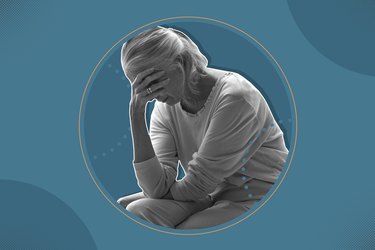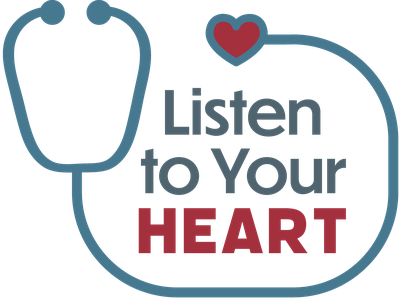
Chances are you know at least one person who's had a stroke. Someone in the U.S. has one every 40 seconds, and someone dies of a stroke every four minutes, according to the Centers for Disease Control and Prevention.
People assigned female at birth are particularly at risk: One in five will have a stroke at some point, according to the American Stroke Association. (Among those, Black people have the highest prevalence.)
Video of the Day
Video of the Day
You're more at risk if you're pregnant (pregnant people are three times more likely to have a stroke than others of the same age) and if you experience migraines with aura, take birth control pills (especially if you have high blood pressure) or have the irregular heartbeat condition atrial fibrillation.
Especially if you fall into any of these categories, it's key to understand what a stroke is, and what the ramifications are on your body.
"It's really important for people — even young, healthy adults — to know what stroke symptoms are, so that they can recognize the signs and get medical attention when they need it," says Zeshaun Khawaja, MD, a stroke specialist at the Cleveland Clinic. "You lose 1.9 million brain neurons every minute during a stroke. That's why literally every second counts."
Here's a look at the full-body effects of a stroke.
Ischemic vs. Hemorrhagic Stroke
There are two different types of stroke: ischemic stroke, which accounts for about 87 percent of all stroke cases, and hemorrhagic stroke, which accounts for about 13 percent.
During an ischemic stroke, arteries to your brain get blocked or become narrowed by a blood clot, says Dr. Khawaja. During a hemorrhagic stroke, an artery in the brain bursts open. This can be due to high blood pressure, too much blood thinning medication or an outpouching of a blood vessel wall (aka an aneurysm).

Your Brain Loses Oxygen
A stroke happens when blood flow to an area of the brain is blocked or when a blood vessel in the brain bursts.
"Blood carries oxygen to cells, so when brain cells are starved of it, they die," Dr. Khawaja says.
Problems with memory, concentration and thinking are very common side effects of a stroke. This is more likely to occur with strokes on the left side of your brain, as that's the region that controls reasoning, planning, judgment, memory and other thought processes, explains Charles Matouk, MD, a stroke specialist and chief of neurovascular surgery at Yale Medicine.
A July 2015 study in the Journal of the American Medical Association found that these problems with memory and thinking ability can keep getting worse for years afterward — and happen faster than normal brain aging.
You can talk to your neurologist about brain retraining techniques, which are designed to improve your thinking and memory after a stroke, although there's limited research as to how well they work.
You should also try to keep your brain as active as possible, to help build back neurons, Dr. Matouk adds. Consider taking up a new hobby, like trying to learn a new language or even just playing new board games every few days.
The other effects of a stroke can vary depending on where in the brain the stroke occurs and how many brain cells die.
What It Might Feel Like
Symptoms come on suddenly and may include confusion, trouble seeing and a severe headache without a known cause. Disorientation, confusion or memory problems are more common stroke symptoms in people assigned female at birth.
Your Face, Arm or Leg May Become Paralyzed
The damage a stroke does to brain cells and connections can cause paralysis on one side of the body. This is usually the side opposite the side damaged by the stroke.
So, for example, if the stroke was on the right side of your brain, your left leg, arm or even your entire left side may be paralyzed, Dr. Matouk says.
The best chance you have to make a full recovery is to begin rehabilitation therapy as soon as possible.
"You'll see the fastest improvements immediately after injury because the brain is rapidly forming new neural connections to recover from the damage," Dr. Matouk says.
An April 2015 study in Stroke, for example, found that the greatest improvements in motor function after stroke were seen in the first two months.
What It Might Feel Like
Arm weakness is a classic sign of a stroke, as is trouble with walking or a lack of coordination. You might also notice facial paralysis if the nerves that control the muscles in your face are damaged. One side of the face may droop or feel numb, and when you try to smile, it may appear uneven or lopsided.
Your Mouth and Throat May Become Uncoordinated
About half of all people who have a stroke experience a swallowing disorder called dysphagia, according to a September 2013 paper in Current Physical Medicine Rehabilitation. That's because a stroke can damage the parts of your brain that coordinate the muscles in your mouth and throat that help you swallow, Dr. Khawaja explains.
Most see dysphagia get better within two weeks, but if you don't, you're at risk for aspiration, which is when something you've swallowed enters your airway and lungs. Because a stroke can reduce sensation, you may not even realize this is happening. As a result, you can get pneumonia.
You may have to temporarily adjust your diet — for example, thickening drinks with special powders to make them easier to swallow, or eating soft, smooth foods like mashed potatoes.
You may also need to undergo speech therapy to learn exercises that will improve the coordination of muscle movements in your mouth and throat.
What It Might Feel Like
You may have trouble swallowing, as noted, and you might also have difficulty with speech.
What to Do if You Think You’re Having a Stroke
Every minute counts when you're having a stroke.
"The longer you let it go untreated, the more brain damage that occurs," Dr. Matouk says.
The American Stroke Association recommends using the FAST test to determine if you or a loved one is experiencing a stroke. FAST stands for:
FACE: Does one side of the face droop or is it numb? When you smile, is it uneven or lopsided?
ARM: Is one arm weak or numb? When you raise both arms, does one drift downward?
SPEECH: Is speech slurred? Are you unable to speak or hard to understand? Can you repeat a simple sentence?
TIME: If you have any of these symptoms, call 911. Also look out for symptoms like sudden numbness, confusion, trouble seeing or walking and a sudden severe headache.
It's important to get to a hospital within four and a half hours of having a stroke, so you can get a clot-busting drug known as alteplase, says Dr. Khawaja. This can help reduce the long-term effects of a stroke. Other treatments include using a device known as a stent retriever to remove the blood clot.
- Centers for Disease Control and Prevention: "Stroke Facts"
- American Heart Association: "Women & Risk of Stroke Infographic"
- Stroke: "Functional and Motor Outcome 5 Years After Stroke Is Equivalent to Outcome at 2 Months"
- Current Physical Medicine Rehabilitation: "Dysphagia after Stroke: an Overview"
- American Stroke Association: "Difficulty Swallowing After Stroke (Dysphagia)"
- JAMA: "Trajectory of Cognitive Decline After Incident Stroke"
- Stroke Association: "Pain After Stroke"
- American Stroke Association: "Stroke Symptoms"
Is this an emergency? If you are experiencing serious medical symptoms, please see the National Library of Medicine’s list of signs you need emergency medical attention or call 911.
